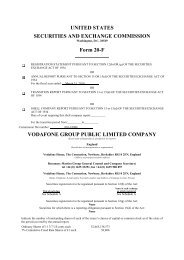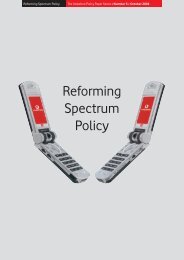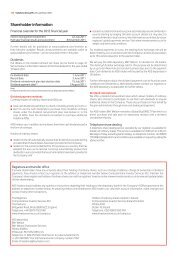The way ahead? - Vodafone
The way ahead? - Vodafone
The way ahead? - Vodafone
You also want an ePaper? Increase the reach of your titles
YUMPU automatically turns print PDFs into web optimized ePapers that Google loves.
Overview<br />
Business<br />
review Performance Governance Financials<br />
<strong>The</strong> relative size of the Group’s intangible assets, excluding goodwill,<br />
makes the judgements surrounding the estimated useful lives critical<br />
to the Group’s financial position and performance.<br />
At 31 March 2013 intangible assets, excluding goodwill, amounted<br />
to £22,025 million (2012: £21,164 million) and represented 15.4%<br />
(2012: 15.2%) of the Group’s total assets.<br />
Estimation of useful life<br />
<strong>The</strong> useful life used to amortise intangible assets relates<br />
to the expected future performance of the assets acquired and<br />
management’s estimate of the period over which economic benefit will<br />
be derived from the asset. <strong>The</strong> basis for determining the useful life for<br />
the most significant categories of intangible assets is as follows:<br />
Licences and spectrum fees<br />
<strong>The</strong> estimated useful life is generally the term of the licence unless<br />
there is a presumption of renewal at negligible cost. Using the licence<br />
term reflects the period over which the Group will receive economic<br />
benefit. For technology-specific licences with a presumption of renewal<br />
at negligible cost, the estimated useful economic life reflects the<br />
Group’s expectation of the period over which the Group will continue<br />
to receive economic benefit from the licence. <strong>The</strong> economic lives are<br />
periodically reviewed taking into consideration such factors as changes<br />
in technology. Historically any changes to economic lives have not been<br />
material following these reviews.<br />
Customer bases<br />
<strong>The</strong> estimated useful life principally reflects management’s view<br />
of the average economic life of the customer base and is assessed<br />
by reference to customer churn rates. An increase in churn rates may<br />
lead to a reduction in the estimated useful life and an increase in the<br />
amortisation charge. Historically changes to the estimated useful<br />
lives have not had a significant impact on the Group’s results and<br />
financial position.<br />
Capitalised software<br />
<strong>The</strong> useful life is determined by management at the time the<br />
software is acquired and brought into use and is regularly reviewed<br />
for appropriateness. For computer software licences, the useful life<br />
represents management’s view of the expected term over which the<br />
Group will receive benefits from the software, but not exceeding the<br />
licence term. For unique software products controlled by the Group,<br />
the life is based on historical experience with similar products as well<br />
as anticipation of future events which may impact their life such<br />
as changes in technology. Historically changes in useful lives have not<br />
resulted in material changes to the Group’s amortisation charge.<br />
Property, plant and equipment<br />
Property, plant and equipment also represent a significant proportion<br />
of the asset base of the Group being 14.2% (2012: 13.4%) of the<br />
Group’s total assets. <strong>The</strong>refore the estimates and assumptions made<br />
to determine their carrying value and related depreciation are critical<br />
to the Group’s financial position and performance.<br />
Estimation of useful life<br />
<strong>The</strong> charge in respect of periodic depreciation is derived after<br />
determining an estimate of an asset’s expected useful life and<br />
the expected residual value at the end of its life. Increasing<br />
an asset’s expected life or its residual value would result in a reduced<br />
depreciation charge in the consolidated income statement.<br />
<strong>The</strong> useful lives and residual values of the Group’s assets are determined<br />
by management at the time the asset is acquired and reviewed annually<br />
for appropriateness. <strong>The</strong> lives are based on historical experience<br />
with similar assets as well as anticipation of future events which may<br />
impact their life such as changes in technology. Furthermore, network<br />
infrastructure is only depreciated over a period that extends beyond<br />
the expiry of the associated licence under which the operator provides<br />
telecommunications services if there is a reasonable expectation<br />
of renewal or an alternative future use for the asset.<br />
Historically changes in useful lives and residual values have not resulted<br />
in material changes to the Group’s depreciation charge.<br />
Additional<br />
information<br />
87<br />
<strong>Vodafone</strong> Group Plc<br />
Annual Report 2013<br />
Provisions and contingent liabilities<br />
<strong>The</strong> Group exercises judgement in measuring and recognising<br />
provisions and the exposures to contingent liabilities related to pending<br />
litigation or other outstanding claims subject to negotiated settlement,<br />
mediation, arbitration or government regulation, as well as other<br />
contingent liabilities (see note 21 to the consolidated financial<br />
statements). Judgement is necessary in assessing the likelihood that<br />
a pending claim will succeed, or a liability will arise, and to quantify the<br />
possible range of the financial settlement. Because of the inherent<br />
uncertainty in this evaluation process, actual losses may be different<br />
from the originally estimated provision.<br />
Impairment reviews<br />
IFRS requires management to undertake an annual test for impairment<br />
of indefinite lived assets and, for finite lived assets, to test for impairment<br />
if events or changes in circumstances indicate that the carrying amount<br />
of an asset may not be recoverable.<br />
Impairment testing is an area involving management judgement,<br />
requiring assessment as to whether the carrying value of assets can<br />
be supported by the net present value of future cash flows derived from<br />
such assets using cash flow projections which have been discounted<br />
at an appropriate rate. In calculating the net present value of the future<br />
cash flows, certain assumptions are required to be made in respect<br />
of highly uncertain matters including management’s expectations of:<br />
a growth in EBITDA, calculated as adjusted operating profit before<br />
depreciation and amortisation;<br />
a timing and quantum of future capital expenditure;<br />
a long-term growth rates; and<br />
a the selection of discount rates to reflect the risks involved.<br />
<strong>The</strong> Group prepares and approves formal five year management<br />
plans for its operations, which are used in the value in use calculations.<br />
In certain developing markets the fifth year of the management<br />
plan may not be indicative of the long-term future performance<br />
as operations may not have reached maturity. For these operations,<br />
the Group extends the plan data for an additional five year period.<br />
For businesses where the five year management plans are used for<br />
the Group’s value in use calculations, a long-term growth rate into<br />
perpetuity has been determined as the lower of:<br />
a the nominal GDP growth rates for the country of operation; and<br />
a the long-term compound annual growth rate in EBITDA in years six<br />
to ten estimated by management.<br />
For businesses where the plan data is extended for an additional five<br />
years for the Group’s value in use calculations, a long-term growth rate<br />
into perpetuity has been determined as the lower of:<br />
a the nominal GDP growth rates for the country of operation; and<br />
a the compound annual growth rate in EBITDA in years nine to ten<br />
of the management plan.<br />
Changing the assumptions selected by management, in particular<br />
the discount rate and growth rate assumptions used in the cash flow<br />
projections, could significantly affect the Group’s impairment evaluation<br />
and hence results.<br />
<strong>The</strong> Group’s review includes the key assumptions related to sensitivity<br />
in the cash flow projections. Further details are provided in note 12<br />
to the consolidated financial statements.











